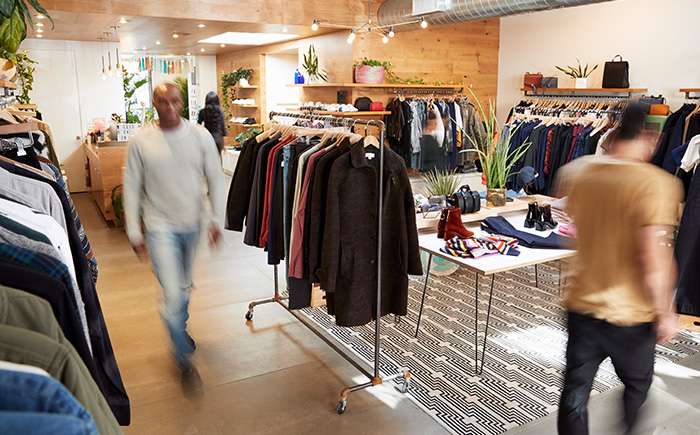- Blog
- Top 5 ways to improve retail CX
Top 5 ways to improve retail CX

In this blog, we discuss the top five ways to optimise your CX processes to ensure your customers have positive experiences with your brand.
The importance of CX in retail
Why is customer experience becoming a key differentiating factor in retail and eCommerce organisations? Let’s take a look at the facts:
- 51% of customers state they will never do business with a company again if they have had just one negative experience
- 93% of consumers say they are more likely to be repeat customers of companies with remarkable service
- 77% of consumers shared positive experiences with their friends or on social media and review sites1.
With 93% of Australians2 expected to maintain or increase their online shopping activity, optimising your online CX initiatives will help drive existing customer retention rates and make it easier to convert new, prospective customers. Consumers essentially have the power to make or break an organisation’s reputation based on their customer experience; that’s why investing in customer experience strategies is worth it in the long term. When considering the financial impact of good CX on a business, a totally satisfied customer contributes 2.6 times as much revenue as a somewhat satisfied customer and 14 times as much revenue as a somewhat dissatisfied customer3.
Digital channel solutions through the use of chatbots, business insights and creative self-serve options are ensuring enhanced customer service. An example includes AI-powered automation that fosters more efficient contact centre communications through a line of intelligent automated call-steering to give businesses an improved self-serve option.
The promotion of self-service is critical, as online channels are slowly starting to overtake the consumers' reliance on brick-and-mortar stores. This means that the face-to-face conversation of ‘do you have this in my size?’ or ‘I am looking for a product that can help me with this?’ can be almost completely removed.
Having self-service options that can replace this interaction can facilitate a seamless and positive customer experience and help manage peak fulfilment demands. Self-checkouts at grocery stores and online site features that allow customers to look up where an item is located exactly in the store are popular examples of retail self-serve options. Online examples can include virtual chatbots, a knowledge base and even discussion forums where consumers can quickly find answers without having to engage with a live customer service agent.
Top five ways to improve retail CX
The fundamental priority for businesses is to create a frictionless journey for customers. A focus on creative solutions and technology-led interventions can contribute to easing customers’ efforts in reaching the resolutions they are seeking. The enduring end goal is to achieve the customer’s objective and facilitate first-time issue resolution.
1. Eliminate friction and reduce effort
In years gone by, businesses only had to focus on a handful of ways a customer could engage with them. Needless to say, those days are gone. As retail channels grow and more eCommerce platforms are introduced, organisations need to be strategic about where they dedicate their efforts, assets and dollars to ensure people get the most out of every interaction. From browsing products and providing feedback to redeeming a voucher and cancelling a purchase, customers have a myriad of reasons for interacting with a business and each of those moments needs to be mapped for each type of customer, along with visitor testing to learn what is working and, more crucially, what is not.
The ability to develop and deliver additional services is crucial to improving customer experience. Instead of a reactive approach to customer service, try to anticipate your customer's needs before they ask. Taking a look at customer behaviour trends is a great way to start.
Being across a customer’s needs and wants is crucial and that stems from not only asking the right questions but doing so regularly. Take time to analyse customer feedback and let them know you are actively working on resolving it. Make them feel heard. There is nothing worse than offering up your advice and not feeling acknowledged.
2. Personalise the customer experience
Creating a personalised CX can work wonders for building rapport and loyalty with your customers. Take a chat window that opens with a generic statement such as ‘How can I help?.’ Now imagine the same exchange beginning with the digital assistant asking an opening question based on the information it has at its disposal - ‘I notice you have placed two scientific novels in your cart. Can I recommend similar authors you may enjoy reading?’ By using readily available first-party data, this chat creates a personalised experience with the potential to yield a much higher return on investment. Technology’s ability to use customer data both in real-time and based on past experiences is playing a huge role in allowing businesses to make recommendations, create targeted campaigns and ultimately build loyalty and trust.
3. Create an omnichannel experience
Offering multiple channels to make a purchase is no longer enough to guarantee loyalty. Consumers want an omnichannel experience, which essentially translates to seamless shopping regardless of whether they are online, on a telephone or on a traditional shopfront. With customers more digitally savvy than ever, it is essential to identify individual and collective preferences and behaviours to ensure they get what they want when and where they need it without disruptions.
4. Automate CX processes
Automation is changing CX for the better. Fewer human errors and more streamlined processes are resulting in happier customers as they venture along their purchasing journey. Automation also has a powerful role to play in analysing the customer experience. While feedback data, such as an open-ended survey, can shine a spotlight on a business’s CX practices and pinpoint where to focus one’s energy, at a scale they can also be difficult for humans to analyse and lead to decisions based on hunches or random selections. Automation takes the guesswork out of such activities, with CX solution suites able to tap into customer data and provide an overall view of how customers interact, what they want and what areas may need to be reinvented.
5. Recode operating models and processes
With a redesigned and streamlined customer experience, the next step is to walk in their shoes through the organisation - optimising processes and eliminating redundant structures. It’s important to base the approach on a ‘customer first’ attitude and redesign the operation around customer needs rather than departments such as online support.
Critical at this stage is taking an outside-in perspective and not being held back by traditional ways of working - ‘the way things work around here.’ Step into the customer’s shoes and view the organisation as a system that exists to deliver value to the customer. Focus on the work that needs to be done and understand how it flows through the organisation. Eliminate unnecessary diversions that can cause delays and errors, and ensure that the right metrics around a ‘first time right’ approach are in place to track this flow - the organisation’s role in helping the customer is key.
How Probe CX solutions can improve your CX
From eCommerce pioneers to established brick-and-mortar operators, it has never been more important to meet customers where they want to engage and that is increasingly in the digital realm. Whether you want to innovate, transform or simply deliver an exceptional customer experience, Probe CX has the knowledge and tools to help make it happen.
Reference
1.https://cdn2.hubspot.net/hubfs/137828/Certification_Files/Inbound%20Certification%20(IC)/InboundCertification_Fundamentals_deck.pdf
2.https://auspost.com.au/content/dam/auspost_corp/media/documents/ecommerce-industry-report-2022.pdf
3.http://infoquestcrm.co.uk/about/case-studies-2/
%20tech-%20a%20banking%20and%20finance%20gamechanger-3.jpg)
-3.jpg)
